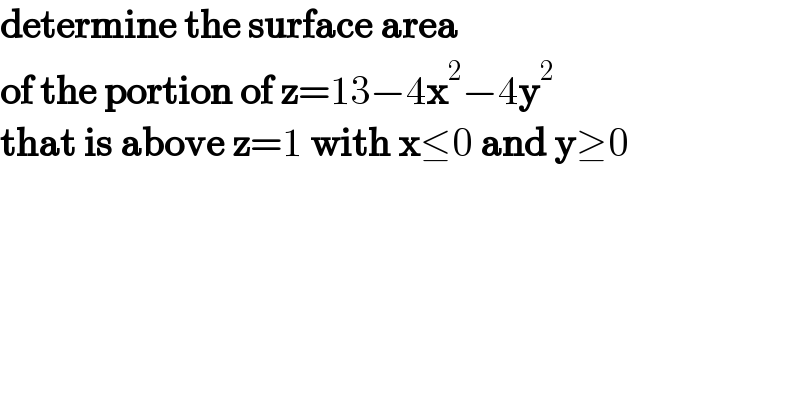
Question Number 189257 by Gbenga last updated on 14/Mar/23

$$\boldsymbol{\mathrm{determine}}\:\boldsymbol{\mathrm{the}}\:\boldsymbol{\mathrm{surface}}\:\boldsymbol{\mathrm{area}}\: \\ $$$$\boldsymbol{\mathrm{of}}\:\boldsymbol{\mathrm{the}}\:\boldsymbol{\mathrm{portion}}\:\boldsymbol{\mathrm{of}}\:\boldsymbol{\mathrm{z}}=\mathrm{13}−\mathrm{4}\boldsymbol{\mathrm{x}}^{\mathrm{2}} −\mathrm{4}\boldsymbol{\mathrm{y}}^{\mathrm{2}} \: \\ $$$$\boldsymbol{\mathrm{that}}\:\boldsymbol{\mathrm{is}}\:\boldsymbol{\mathrm{above}}\:\boldsymbol{\mathrm{z}}=\mathrm{1}\:\boldsymbol{\mathrm{with}}\:\boldsymbol{\mathrm{x}}\leq\mathrm{0}\:\boldsymbol{\mathrm{and}}\:\boldsymbol{\mathrm{y}}\geq\mathrm{0} \\ $$
Answered by Ar Brandon last updated on 14/Mar/23
![S=∫∫_([D]) (√(1+((dz/dx))^2 +((dz/dy))^2 ))dA z_1 =z_2 ⇒13−4x^2 −4y^2 =1 ⇒x^2 +y^2 =3 0≤x≤(√(3−y^2 )) ; 0≤y≤(√3)](Q189258.png)
$${S}=\int\int_{\left[{D}\right]} \sqrt{\mathrm{1}+\left(\frac{{dz}}{{dx}}\right)^{\mathrm{2}} +\left(\frac{{dz}}{{d}\mathrm{y}}\right)^{\mathrm{2}} }{dA} \\ $$$${z}_{\mathrm{1}} ={z}_{\mathrm{2}} \:\Rightarrow\mathrm{13}−\mathrm{4}{x}^{\mathrm{2}} −\mathrm{4y}^{\mathrm{2}} =\mathrm{1}\:\Rightarrow{x}^{\mathrm{2}} +\mathrm{y}^{\mathrm{2}} =\mathrm{3} \\ $$$$\mathrm{0}\leqslant{x}\leqslant\sqrt{\mathrm{3}−\mathrm{y}^{\mathrm{2}} }\:\:;\:\mathrm{0}\leqslant\mathrm{y}\leqslant\sqrt{\mathrm{3}} \\ $$
Commented by Gbenga last updated on 14/Mar/23

$$\boldsymbol{{thanks}}\:\boldsymbol{{sir}} \\ $$
